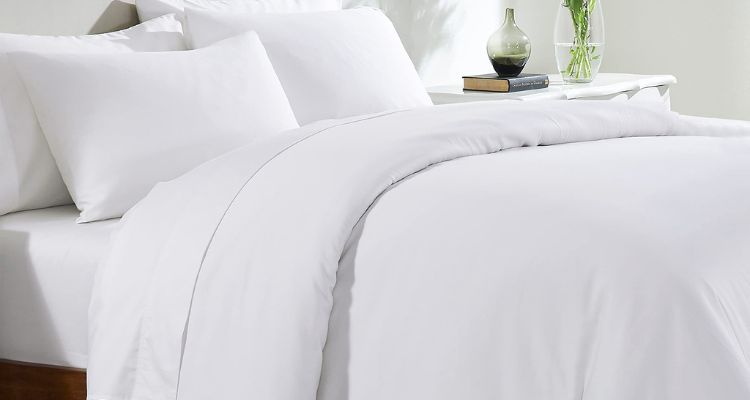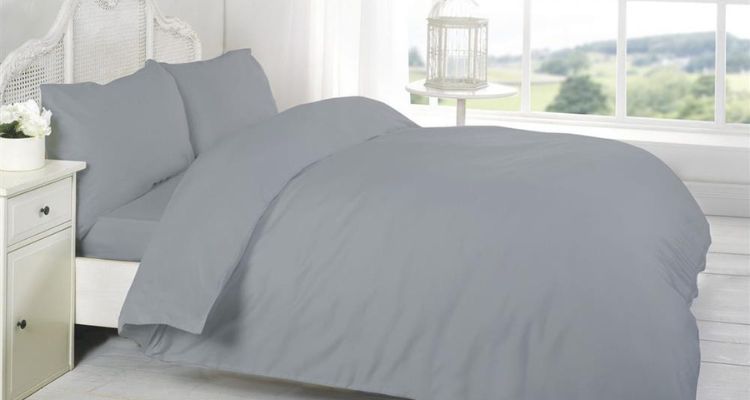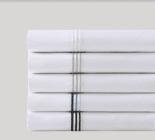With the help of duvet covers, you can change your bedding much more easily, and washing it becomes much simpler. You can conveniently remove these covers when you need to wash them.
They are pretty good in comfort and style compared to other bedding types. But these duvet covers tend to be expensive. So, you should look for the right materials ideal for your requirements.
We have developed this guide for your assistance, and we will discuss the different types of materials you can go for when it comes to duvet covers. So, give it a read and find everything you need about the various duvet cover materials the market offers.
The most comfy and luxurious duvet cover we recommend
What’s the Best Fabric for a Duvet Cover?
These duvet covers are available in different fabrics, and you can choose one according to your preferences. We have made a list of some of the best options available that you can choose from.

Cotton
It’s among the best fabrics for any purpose, and the same is true with duvet covers. Cotton is affordable and highly breathable. It’s exceptionally lightweight and pretty simple to clean. These are the features that everyone looks for in fabric materials for these duvet covers.
If you are looking for a duvet cover that is cozy and soft, you should consider going for the high-quality variety. Egyptian cotton, Supima, and Pima are the ones that have the exceptional quality to offer.
These types are long-staple cotton and have fibers longer than traditional cotton. So, these types of cotton are stronger and softer.
Apart from that, these types of cotton come with a higher thread count, making them soft. But you need to remember that this long-staple cotton is much more expensive.
Percale cotton
Percale cotton is another type of cotton that is a suitable choice for duvet covers. It’s a fabric that hotels frequently use for their sheets and other bedding accessories.
This stuff is lightweight and highly breathable. However, it has a relatively lower thread count. So, it will be soft but not as soft as the long-staple cotton, as discussed above.
Threads in percale cotton are woven tightly, and it’s incredibly durable. So, duvet covers made of this fabric tend to last pretty long. Moreover, this fabric is pretty easy to wash and clean. But there is not much fabric variety available here.
Linen
Another lightweight material that you can consider for your duvet cover is linen. Linen is a common material that is used for bedding accessories. So, if you are a hot sleeper, you should consider going for linen (check 6 amazing linen duvet covers).
It is highly breathable, keeps you cool at night, and is extremely soft. If you take enough care, this stuff can last for many years. But you need to be very careful when washing it as it does tend to shrink.
It’s an ideal option for use in your guest room (also check the top rated mattresses for guest room), where it won’t go through a lot of wear and tear. You might not find as much variety in linen as it is available in cotton. But linen is a good choice if you want an airy and light look in your bedroom decor.
Cotton/polyester blend
Choose the cotton and polyester blend if you want an affordable material for your duvet cover. This blend is readily available, and you won’t have trouble finding it. Furthermore, a wide range of patterns and colors are available for you to pick from.
It is another pretty durable fabric, and you can wash it conveniently. So, you can conveniently use it in your pet’s or kids’ rooms. But there is a drawback as well; this stuff is not highly breathable, especially if you compare it with linen and cotton.
It might not feel as soft or comfortable, either. But that all will rely heavily on the blend and how much of it does have cotton and how much of it is polyester.
Silk
Considering the most luxurious type of duvet cover material? Choose silk over anything else. It is much smoother, agent, and shiny compared to any other options discussed above.
Moreover, silk is highly breathable, so if you tend to sleep hot, you’ll love this as your duvet cover. You have to pay for such lavish and quality material. It is the most expensive of all materials that you will find for your duvet cover.
Some cheaper options are available, but they are not silk and are made of polyester and won’t have the same level of breathability.
Besides, silk is among the more delicate materials and is hard to maintain and wash. This is not the type of stuff you should have in your kids’ or pet’s bedroom.
Flannel
Another one of the softest materials you can find for duvet covers is flannel, which is the warmest on this list. This material is made of brushed cotton and has a fuzzy texture which is pretty unique.
This stuff is easy to clean and is extremely lightweight and durable. Duvet covers made of flannel will be ideal for colder climates and work well during winters. But this is not the right option for hot sleepers.
What is the Most Breathable Fabric for a Duvet Cover?
The most breathable fabric out there for you to consider is cotton. It is lightweight and soft, and cotton duvet covers are the best if you tend to sleep hot. Linen is another good option that you can choose if you are looking for breathable materials for your duvet cover.
Both these materials are extremely durable and very easy to clean. But you must remember that linen tends to shrink when it is, so you must be careful about that.
Silk is another highly breathable option, but it is excessive and delicate. Hence, cotton is the best option in every aspect and the one that is the most breathable of all.
What is the Most Durable Fabric for a Duvet Cover?
Consider percale cotton if you are looking for a fabric for your duvet cover that is the most durable. It’s lightweight and breathable and has a lower thread count. But these threads are tightly woven, which is why this material is pretty strong.
This is the best option if you want duvet covers in your kids’ or pets’ bedrooms. It is also pretty easy to clean and wash. You might not get as many fabric varieties here, but its durability is top-notch.

What Fabrics Should You Avoid for Duvet Covers?
You must avoid certain types when looking for the best fabrics for your duvet covers. For instance, don’t go for anything that is considered to be a heavyweight fabric.
Don’t consider jacquard or brocade, as they tend to be heavier. These fabrics are not very breathable, well. Duvets should be lighter than comforters, and if you go for a heavier fabric, it will only weigh the duvet down.
Only consider lightweight and highly breathable fabrics. They are much easier to maintain and clean because they are lighter. So, lightweight fabric will help you maintain and clean easily.
How to Choose Fabric for a Duvet Cover
As we have established that there are different types of fabrics, it’s time to find out how you would know which one is the best for you.
Ease of care
You must look for a fabric that is easy to clean and maintain. Duvets covers have a design that lets you remove them from your duvet insert and wash them conveniently.
Therefore, go for a fabric that is easy to clean, especially if this duvet cover comes from your kids’ or pets’ room.
Cotton, flannel, and cotton/poly blends are easy to clean and maintain. However, linen and silk are difficult in this aspect.
Appearance
Consider your bedroom decor and choose fabrics that fit the bill. Different fabrics are available in different patterns and colors.
A much larger fabric selection will be available in fabric types such as cotton/poly blends and cotton. But there is not much variety available if you want flannel, percale, linen, or silk.
Cost
Cost is another critical factor, and you must remember to purchase multiple yards of fabric. Therefore, go for the nice fabric that you can conveniently afford.
Opt for the one with all the features you want, which should not have a premium price tag. Silk is the most expensive, and so is long-staple cotton. But percale, linen, and cotton/poly blend are good budget-friendly choices.
Don’t forget embellishments
These duvet covers slip over your duvet insert and are secure in place. It means they won’t come off, and the duvet inserted inside the cover won’t shift. So, there should be a way to secure the cover in place.
The common way to do that is to include zippers, ties, or buttons. You must buy the necessary supplies for securing a particular fabric. Other embellishments include the likes of ribbons, etc.
How Much Fabric for a Duvet Cover?
To make a duvet cover, you must know how much fabric is needed. It just depends on the overall size of your bed. Here are some duvet sizes and how much fabric you need for them in general:
- 39-inch x 75-inch twin mattress → 69-inch x 90-inch duvet → 6-yard fabric each side.
- 54-inch x 75-inch full mattress → 86-inch x 90-inch duvet → 6-yard fabric each side.
- 60-inch x 80-inch queen mattress → 90-inch x 96-inch duvet → 6 yards fabric each side.
- 78-inch x 80-inch king mattress → 109-inch x 96-inch duvet → 6 yards fabric each side.
For a twin bed, you might have more leftover fabric. But it will ensure you have plenty to make adjustments if any are required.
You must remember that 6 years is the amount of fabric you will need for each side, and you must double it to make both sides. This way, you will have plenty of fabric for any bed size.
Key Takeaways: Best Material for Duvet Cover
Understanding Duvet Cover Fabrics
Duvet covers, integral to our sleeping experience, come in a variety of materials to cater to different needs. For those seeking optimal breathability and softness, cotton stands out, particularly its high-quality varieties like Egyptian, Supima, and Pima cotton. These long-staple cotton types offer strength and unparalleled softness. Percale cotton, frequently used in hotels, boasts durability with its tightly woven threads. For a lighter and airy bedroom aesthetic, linen, although prone to shrinkage, might be your best bet.
The Luxurious and Practical Choices
When luxury is the priority, nothing surpasses the smoothness and shine of silk. However, with luxury comes the challenges of maintenance and a heftier price tag. On a more practical front, cotton/polyester blends provide a budget-friendly alternative, ensuring durability especially in spaces occupied by kids or pets. Still, this blend might not be as breathable as its pure cotton counterpart.
Factors to Consider When Choosing a Duvet Cover Material
When embarking on the journey to find the perfect duvet cover, consider the ease of care, appearance, cost, and any additional embellishments. While cotton and its blends generally offer ease of cleaning, materials like silk require more delicate care. Align your choice with your bedroom decor, keeping in mind the patterns and colors available in each material. Cost should also factor in, as materials like silk tend to be on the pricier side. For a complete duvet setup, don’t forget to account for securing mechanisms like zippers or buttons, which ensure the duvet stays in place.
Conclusion:
There is a wide range of different materials that are used to make duvet covers. And they all have their pros and cons. Cotton is the best option because it is lightweight, durable, breathable, and easy to clean.
Linen is another option similar to cotton, but it tends to shrink. Warmer duvet covers are made of flannel, while the more expensive ones are made of silk. Budget-friendly duvet covers are made of cotton/poly blend.
So, there are different types of materials. They fulfill various purposes. Hence, you have plenty of options according to your requirements.
This is the beauty of duvet covers; they are highly versatile and are suitable for almost any purpose. If you are looking for a duvet cover for your bedroom, kids’ room, or guest room, this one is just for you.
Best material for duvet cover FAQs
What is the softest duvet cover material?
The softest material for a duvet cover is silk. It is smooth and breathable but also pretty expensive and tough to maintain and clean because it's too delicate.
So, the next best option is long-staple cotton, which is soft, breathable, durable, and easy to clean and maintain.
What is the warmest duvet cover material?
The warmest material for a duvet cover is flannel made of brushed cotton. This brushed cotton has a unique texture and is quite warm.
So, warm that it is only suitable for colder climates, and it won't work for you if you are a hot sleeper. This duvet cover material is not ideal for warmer climates or summer.
Is it better to have a cotton or polyester duvet cover?
Cotton is always a better option than polyester. Polyester is not breathable, and it is slightly tougher to maintain as well. On the other hand, cotton is breathable, light, and very easy to maintain.
Moreover, it is much softer too. Of course, cotton is much more durable as well. But polyester is better if you want to put a bed in your pet’s or kids’ room.
What duvet do they use in hotels?
The duvet covers that they use in hotels are made of percale cotton. Percale is extremely durable as its small fibers are tightly woven together.
But percale is extremely soft and highly breathable. So, it is a good option for anyone who sleeps hot.
They use percale in hotels because percale is pretty easy to clean and maintain. Besides, percale is highly durable and can stand the test of time.
It’s lightweight and breathable. So hot sleepers won’t have trouble sleeping on a duvet cover made of percale. But, as it is a good voice for most users, hotels prefer using it over other fabric types.


